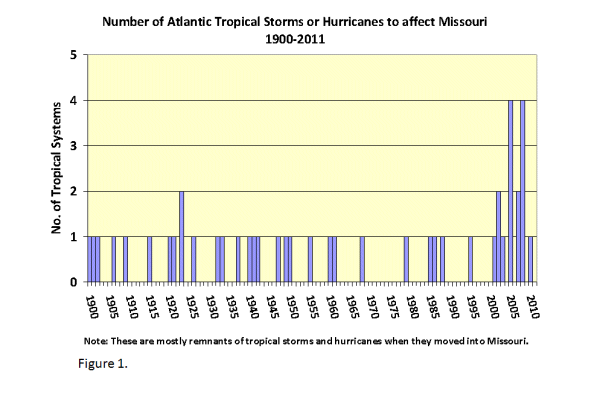
Tropical Storms in Missouri
Pat Guinan
State Climatologist
Commercial Agriculture/University of Missouri Extension
August 30, 2012
As summer progresses conditions tend to become more favorable for tropical storms and hurricanes to develop in the Caribbean and Gulf of Mexico. Most people tend to think these storms only affect states along the Gulf and Atlantic coasts and, for the most part, this is true. Hurricane force winds and storm surges are effects usually reserved for the shoreline and nearby coastal communities, but there have been instances of hurricane force winds (>73 mph) extending over 200 miles inland and tropical storm force winds (39-73 mph) experienced as far inland as Kansas and Iowa. Additionally, remnants of hurricanes can bring widespread rainfall to states hundreds of miles from the coast.
The remnants of 44 hurricanes and tropical storms affected Missouri between 1900 and 2011 (Figure 1). Southeastern Missouri is the most likely area to be impacted and, of these 44 systems, six maintained their tropical storm status when they moved into the state.
The first tropical storm to affect Missouri occurred overnight on September 10, 1900. Two days earlier, this storm was a catastrophic hurricane that struck Galveston, TX and killed more than 6,000 people. The hurricane made landfall at Galveston and moved west to San Antonio by the morning of the 9th. From there, it turned northward and rapidly moved across Oklahoma and Kansas during the 10th reaching the vicinity of Des Moines, IA on the morning of the 11th. The storm passed over the extreme northwestern portion of Missouri during the night of the 10th, causing high winds over the northern counties, which caused damage to orchards, hay stacks, corn, and fencing.
The second tropical storm swept through Missouri on June 28-29, 1902, tracking quickly from Joplin to St. Louis and dropping light precipitation totals due to its rapid movement.
The third tropical storm to hit Missouri occurred in late September 1906. On the morning of the 27th, a powerful hurricane was near the mouth of the Mississippi River. The hurricane weakened to a tropical storm as it moved northward through Mississippi, Tennessee, Arkansas, into southeastern Missouri. During the succeeding 24 hours the tropical storm center moved over eastern Missouri and southern Illinois. The rain fell steadily for more than 30 hours over the eastern half of the state depositing 2-4 inches of precipitation.
The fourth tropical storm struck southeastern Missouri on September 24, 1941 and traveled from Poplar Bluff to Cape Girardeau.
The fifth tropical storm entered southeastern Missouri from West Plains to Poplar Bluff on October 5-6, 1949. It also was a weakening storm that made landfall in Texas as a powerful hurricane and traveled through Louisiana and Arkansas before striking Missouri.
The sixth tropical storm to impact Missouri occurred in 2008. Hurricane Ike made landfall near Houston, Texas on September 13, 2008 and moved through southeastern Oklahoma, northwestern Arkansas and into southern Missouri on September 14, 2008. The center of the storm traveled northeastward through Missouri from Ozark to Reynolds counties, before being downgraded to tropical depression status.
The past decade has been unusually active for Missouri, with 13 named tropical systems impacting the Show Me State between 2002 and 2011. A record four named Atlantic tropical systems affected Missouri in 2005 (Arlene, Dennis, Katrina, Rita) and 2008 (Dolly, Fay, Gustav, Ike).
When tropical systems affect Missouri, it's usually during late summer/early fall and, most of the time, they are welcome. They have the potential to drop significant rains over a large area, and act to recharge depleted summer moisture supplies. On average, Missouri is affected by remnants of tropical storms or hurricanes every 2-3 years, whereas the chances a tropical storm will maintain its identity while moving into Missouri is about 1 in 20 years. A full-fledged hurricane has never been witnessed in Missouri.













